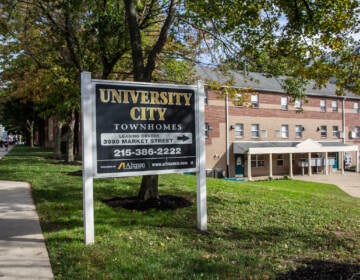How Philly’s biggest 2020 real estate deal could create opportunities for Philly students
Hilco has promised a first-of-its-kind public-private partnership that offers a new pathway into skilled professions for Philadelphia public school students.

Jasmine Sessoms’ job: to be liaison with the community, government, businesses and media as her company recreates the property. She welcomes the challenge. (Hilco Redevelopment Partners)
When Hilco Redevelopment Partners (HRP), a real estate investor that remediates obsolete industrial sites, bought the 1,300-acre former Philadelphia Energy Solutions refinery out of bankruptcy in June, all eyes were on the Chicago-based company.
For $225 million, Hilco bought the sprawling site with a plan to transform it into a distribution and commercial hub with warehouses and the state-of-the-art logistics infrastructure needed in the era of Instacart and Amazon.
Environmentalists, Philadelphia residents, and advocacy groups demanded environmental justice and a cleaner future for the site, as well as equitable job-creation to replace the refinery’s lost union jobs. The refinery was the biggest polluter in the city and the cause of longstanding suffering for the surrounding community, both before and after the site’s explosion and fire in June 2019.
Now, the South Philadelphia refinery is offering a first-of-its-kind public-private partnership that promises a new pathway into skilled professions that historically have been dominated in Philly by white men groomed by the city’s powerful unions.
The new initiative, called a Career-Connected Learning System, pledges to connect thousands of Philadelphia public school graduates to an estimated 20,000 jobs in the fields of logistics and distribution, with guaranteed opportunities for upward mobility after a year-long apprenticeship.
This program has already proven a multimillion-dollar worth — in the form of a valuable tax cut. Hilco needed approval from Philadelphia’s City Council and the Board of Education for the extension of a key financial assist — the state’s Keystone Opportunity Zone tax incentive. It received an almost unanimous vote by City Council, but in a surprising vote, the school board initially voted against the public aid. The stunning vote against the tax subsidy sent Hilco searching for a way to sway critics on the board. Enter career-connected learning.
“The game-changer was CCL,” said Jasmine Sessoms, senior vice president of Hilco’s corporate affairs, and a South Philadelphia native. “It came about thinking through what a meaningful investment would be in the school district. Working hand-in-hand is really what changed the tides.”
The plan has set an ambitious goal to diversify the building trades, with a 50% minority workforce participation goal, a 50% local employment goal, and 5-8% women-owned businesses, according to HRP’s Economic Opportunity Plan, a document created to ensure the use of minority-, women-, and disabled-owned businesses on contracts over $100,000.
“What was really exciting to me, when the Hilco project came across my desk, was that this was an opportunity for us, in the beginning of the work, to solidify a partnership with an employer that was going to be truly engaged in the work … on both ends,” said Alexandra Robinson-Rogers, executive director of post-secondary readiness at the School District of Philadelphia, and district point-person for the Hilco project.
1,300 acres, 33,000 jobs, new opportunities
The lower Schuylkill property is 1,300 acres — a sprawling maze of oil drums and industrial infrastructure that occupies 2% of the city. It’s in a strategic location between Center City, University City, Philadelphia International Airport, and the Philadelphia Navy Yard. Hilco’s plan for a modern logistics center is estimated to create 13,000 construction jobs, and nearly 20,000 permanent jobs when completed.
Workers at the refinery historically came up through a union system with a long history of exclusionary politics and racial segregation. In the 1960s, the NAACP led demonstrations against racist hiring practices. President Lyndon B. Johnson in 1965 signed Executive Order 11246 in an effort to end such hiring practices in the construction fields. It was widely recognized as the “Philadelphia Plan,” connoting the city’s national reputation of union racism. In 2009 two Philadelphia unions reported a 40% minority membership, but none had Black membership higher than 20%. Nearly half of the city’s population is Black.
The IUOE Local 54 union, which has over 6,000 members in the building and construction industry and includes five districts, has been under a federal court decree since the late 1970s due to “racially charged” incidents, and has been under court supervision for most of the last 40 years, WHYY reported in 2017.
Before Hilco even bought the site last summer, the city and school district were in conversation about developing a CCL system that could help break that cycle and bring more young Philadelphians into well-paying jobs. The model would allow employers to provide career exposure for students while they’re still in middle and high school and prepare young people for entering the workforce through apprenticeships and internships. Now that model will happen through Hilco.
“They’re creating a model to foster preparing students to enter the union,” said Sylvie Gallier-Howard, the former acting director of the Philadelphia Commerce Department, which will lead the project on the city side. “This will be almost all students of color.”
In order to get students into sustainable careers, the district needs to both understand employers’ needs and provide various opportunities for students to learn and explore, she said. HRP is guaranteeing just that.
The jobs will emphasize areas of growth for the city. Green jobs, advanced manufacturing, life sciences, financial services, and tech are some of the anticipated arenas, said Gallier-Howard, who left the Commerce Department in December.
“These aren’t going to be minimum wage jobs,” she said, noting that the coming hub will house headquarters and offices of major distributors and e-commerce companies in addition to warehouses.

Subscribe to PlanPhilly
What is career-connected learning?
The Career-Connected Learning framework, also known as “work-based learning,” was developed and launched by the nonprofit Washington STEM, in Washington state. The model is not a one-size-fits-all solution, and needs to be fitted to the continuum of needs of a community.
Hilco’s proposal laid out comprehensive plans that would ensure hands-on experiences for middle and high school students, preparing them to secure jobs. The proposal required myriad measurable commitments from both Hilco and its contractors, beginning with securing $1 million from Philadelphia Works, which will be used for design plans and early implementation of career preparation activities, specifically pre-apprenticeships. These preparatory activities are to get students ready for post-graduation professional apprenticeships, and any other post-secondary training essential for procuring permanent employment.
A CCL framework always has to be customized to the particular place, said Gallier Howard. The partnership worked with a consultant to help them fit the program to fit Philadelphia.
The driving question on the table has been “how can we take these existing [CCL] models and scale them up so it’s really truly equitable,” she said.
There are several aspects of the HRP plans that make this project particularly unique. From the sheer size and job scope, to the longevity of commitment, to the long-term active collaboration between government and the developer.
“This is a pilot program in every way,” Sessoms said.

The project’s 10-year lifespan makes it possible for the partnership to follow the career journey of the students — to recruit, train, employ, and follow up. The ability to be involved in the “life cycle” of the student makes this approach particularly unique. Ideally, the program will take young people from internship to apprentice to permanent paycheck.
“You can go right into a really good job,” Sessoms said.
Though the project is still a newborn, there is a metrical vision for tracking the success of the program.
“We will want to look at the trajectory of these students. The first thing we need to do is figure out the structure of the organization and invest in a data system,” Gallier Howard said. “And build that information so everything can be tracked.”
A new precedent for community benefits
The city’s Commerce Department and School Board are hoping the Hilco project inspires other companies. The two agencies worked together to set a new precedent, requiring any interested firms to fill out a student commitment form specifically detailing how they will commit to the students, commensurate with their project, Gallier-Howard said.
“It’s a massive opportunity, especially during these challenging times, for these projects to have intentional plans for creating community benefits,” she says.
It is common, when preparing students for careers, to look to technical education programs as the end-all, Robinson said. Philly is no different, in that respect. But in her 15 years of experience, those career fields have only fit a small portion of the student population.
The school district leader said the agency won’t be pushing any student towards one pathway or another. Instead, the system is ready to support students in what they choose, and make sure that each high school student has access to the same career exposure opportunities and work-based learning opportunities.
“It’s important for people to understand that as a district we are not taking this lightly,” Robinson said. “We are working internally to not only ensure that career-readiness is embedded into our curriculum, but that we are designing the necessary supports for every student to be supported along their pathway, whatever that is.”
Correction: Jan. 10, 2021
An earlier version of this article erroneously referred to Sylvie Gallier-Howard as the Acting Director of the Philadelphia Commerce Department. She held the position when she spoke to the reporter but left the Commerce Department in December of 2020, prior to the article’s publication.
 WHYY is one of over 20 news organizations producing Broke in Philly, a collaborative reporting project on solutions to poverty and the city’s push towards economic justice. Follow us at @BrokeInPhilly.
WHYY is one of over 20 news organizations producing Broke in Philly, a collaborative reporting project on solutions to poverty and the city’s push towards economic justice. Follow us at @BrokeInPhilly.
WHYY is your source for fact-based, in-depth journalism and information. As a nonprofit organization, we rely on financial support from readers like you. Please give today.







